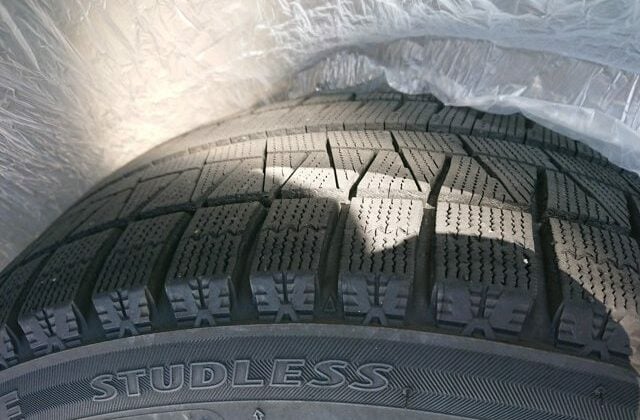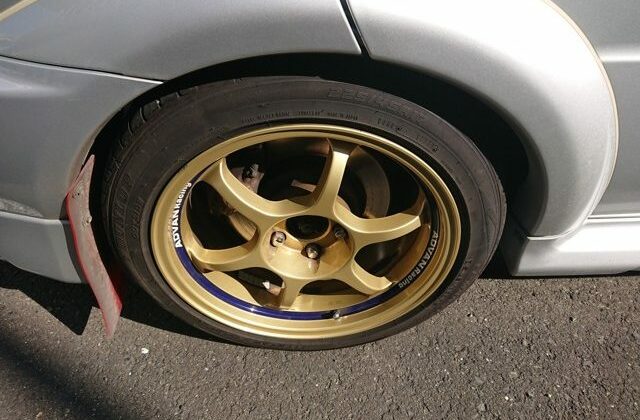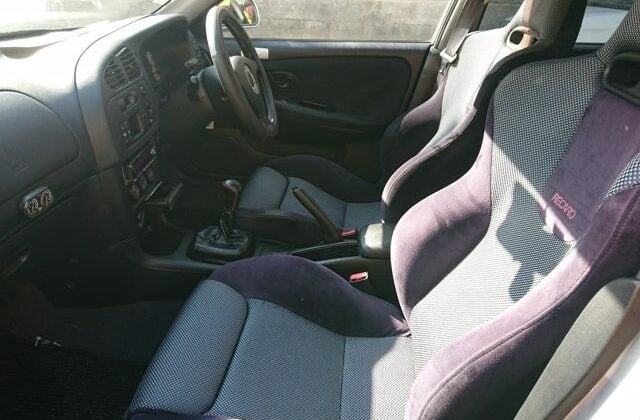1998 Mitsubishi Lancer Evolution V (GSR)
Sold and Exported
High Tech Muscle and Bang for the Buck: Lancer Evolution All the Way
If you want a used Japanese supercar from the ‘90s (which can now be imported to the USA) that gives you reliable low five (or even sub five!) second 0-60 times, you’ve got three really good choices: The Toyota Celica GT-Four, the Subaru Impreza WRX STi, and the Mitsubishi Lancer Evolution. I call these cars the “244T” cars. They’ve got 2-liter, 4-cylinder engines, 4-wheel-drive, and are Turbo charged. So in my car world they are the 244T class. And a stunning class of performance vehicles they are, just stunning.
These cars are all relatively light, with the GT-Four being the heaviest at 1,380kg, and with the lighter examples of the STi and the Evo coming in at under 1,300kg. That is light for cars producing from, say, around 250ps all the way up to over 300ps. We’re talking only the cars from the 1990s here, guys, because those are the cars I know (I’ve had a 1995 GT-4 and a 1996 STi) and also because they are in the “sweet spot” right now if you want to import a used all-wheel-drive supercar from Japan yourself. (Time of writing: summer, 2021.) If the used car from Japan that you are looking at is over 25 years old it is easy to import it to the USA or to Australia. It is also easy to import these cars to New Zealand, Canada, and, of course, to the UK, where, if the car is only 10 years old, it’s easy to import and MOT. (To see the used car import rules for these countries, just click on the country name above.)
What makes the Lancer Evolution So Great
Let’s look more now at this beautiful silver Mitsubishi Lancer GSR Evolution V that we recently exported to New Zealand.

Engine: Simplicity on Your Side
The Evo shares the basic, highly successful, concept that makes the 244T class so great, and so nearly unbeatable, when it comes to supercar performance, handling, and braking, and all for very reasonable money.
Let’s start with the engine: We’ve got a two-liter, straight four cylinder unit: Mitsubishi’s 4G63, a power plant with years of rally successes behind it. It’s an iron block engine that is very solid and can handle high boost pressures; this helps to make the engine fundamentally more reliable, especially in stock form. The aluminum cylinder head has dual overhead cams (DOHC) and had four valves per cylinder; the classic highly-tuned engine format. The 4G63 also has multi-point fuel injection, of course.
Aftermarket tuning support for the 4G63 is very good but….I don’t know, Guys, the car does 0-60 in under five seconds, and so, like my STi, it is already scary fast and feels like it’s going to pull the skin off your face when you floor the accelerator. You really want to make it faster than that?…..Me?….No. Count me out. Stock Lancer Evo for lil’ ol’ me.
Drive Train: All the Rubber on Your Side
But an important point of the engines in the 244T class is that, unlike the monstrous V12 engines you get in your “typical” classic supercar, like in your Lamborghini Countach

or the big V8 you get in your Ferrari F430,

these 4 cylinder units are cheap, easy and economical to tune and repair, and they are LIGHT! So the whole car can be lighter, see?
And what does that lightness give you? Better braking and better handling and better acceleration. (Colin Chapman, guys, listen to Colin Chapman: If you increase power you can go faster in a straight line; if you reduce weight you can go faster in any direction. And you can stop faster, too.)
And with the car being light, you can afford a bit of weight to give you the drive train system that allows you to put all that power to the road reliably and (relatively) safely: All Wheel Drive. Your bog standard Ferrari or Lambo back in the day had to get the power down to the road by putting the engine closer to the rear drive wheels, so as to get the weight over those driven wheels. BUT: You ever power spun your wheels in a midship car? I have. I didn’t think it was thrilling, I thought it was scary. But maybe there are some people out there who like uncontrollable snap over steer..…I’m just not one of them. The Lancer Evo’s AWD system means that you can enjoy all that power in most road conditions (not all, though!) and not have to make your will before you turn the key. The rubber on all four, not only two, of your wheels is thrusting you forward. Max driven rubber in contact with the tarmac equals all engine power working as serious thrust, not silly wheel spin.
Is the magic and wisdom of the Lancer Evo, of the whole “244T” idea becoming clearer? Yeah! This is a winning formula.
Body: Three Dimensional Physics on Your Side
And there is something else about the Lancer Evo that makes good sense and gives good performance and handling: The chassis. Look at the car again, let’s choose a different angle on our New Zealand-bound silver muscle rocket Evo:

Do you see what I see? I see a sedan. Under all that uber-cool, muscular styling, I see four doors, a high roof, and three boxes: engine room, passenger compartment, boot/trunk. Under the steel I see the physics: A naturally rigid body benefitting from the three box, slightly high roof layout means the car can easily be made strong enough to handle the twisting, torquing forces that very powerful sports machinery is subject to.
He’s Got the (Muscle) Look!
In terms of pure looks, although I say that, in the 244T class, the Celica (we recently exported a very fine one to Australia, here) is the most flat out “beautiful”

the Lancer Evo is the most blatantly “muscular.”

Have a look at more of our photos above. This secondhand Japanese supercar, this 1998 Lancer GSR Evolution V, is just so nice to look at. Even just sitting in traffic, this car is mean muscle personified.
(And on a personal note: You’ll see in the photos that we were able to include a second set of wheels, Oz Racing wheels, and tires when shipping this Lancer. Look closely and you’ll see that the tires are snow tires. I always had a set of snow tires for my 244T cars. Used them every year. I live up in the mountains here in Japan, right on Mount Fuji, and it snows, sometimes seriously. With snow tires on your AWD supercar you always get to work on snowy days. I did.)

So if you are thinking: “I want to buy a Lancer Evolution from Japan,” or “How much for a Lancer Evo from Japan,” just register here with us at JCD and we’ll get things moving so that you can get your hands on a nice, clean example of one of the best, and most practical (and most tuneable, for all you guys out there for whom sub five 0-60 stock is not enough) supercars built in Japan in the motor car glory days of the 1990s.

























































































